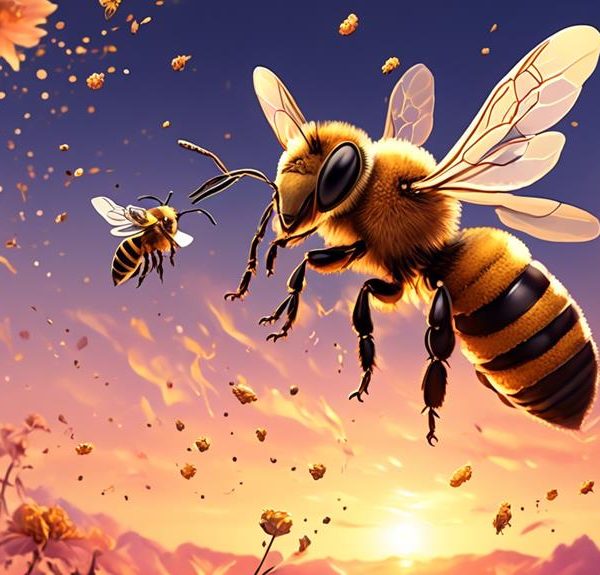Discover safe, effective strategies to remove bees from your tree without harming them or disturbing your serene backyard ambiance.

How to Get Bees Out of a Tree?
Ever faced the buzzing problem of having bees take residence in your tree? There's no doubt it's a delicate situation. After all, bees are crucial pollinators playing a significant role in our ecosystem, but they can be a nuisance or even a danger when they're too close to home.
You're probably wondering if there's a safe, effective way to handle this issue without resorting to harmful pesticides or causing unnecessary harm to the bees. There are indeed several methods to consider, and you'll be surprised to discover how manageable the process could be.
Are you ready to explore these strategies and regain your peaceful backyard?
Key Takeaways
- Bees are defensive and will only attack if they perceive a threat to their colony.
- Use protective gear such as a beekeeper's suit, gloves, and a veiled hat when inspecting a bee hive.
- Start inspections from a safe distance and gradually move closer, but retreat if bees show aggressive behavior.
- Consider contacting a professional beekeeper for safe removal and relocation of bees.
Understanding Bee Behavior
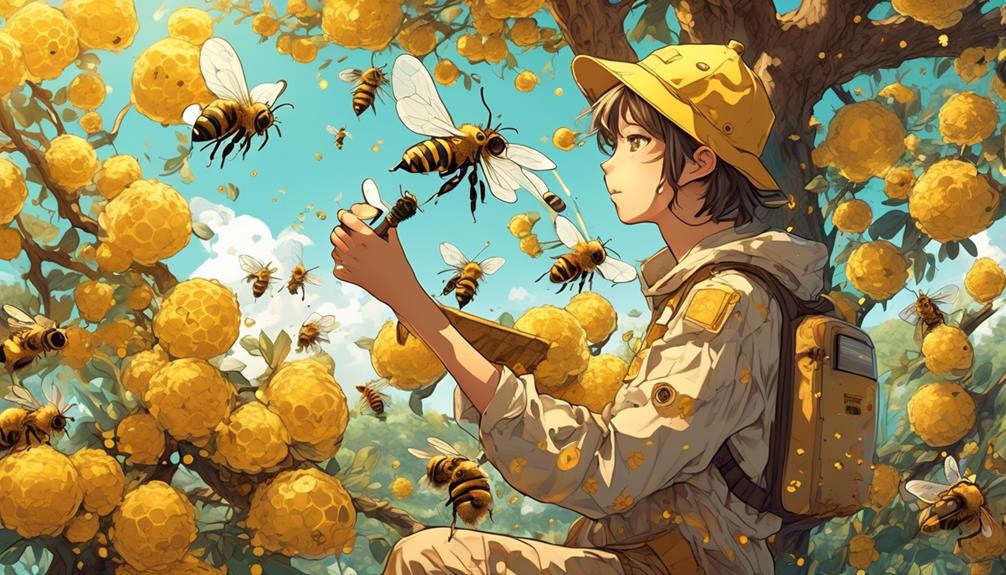
Why is understanding bee behavior vital, you may ask? Well, it's because bees aren't just pests that you can swat away. They're complex creatures with intricate social structures and behaviors, and knowing these can make the difference between a successful removal and a dangerous swarm.
Firstly, you should understand that bees aren't naturally aggressive. They're defensive, and they'll only attack if they perceive a threat to their colony. This means that fast, sudden movements near their hive can trigger an attack. So, if you're dealing with a beehive in a tree, it's crucial to move slowly and calmly.
Next, bees communicate through pheromones. If a bee stings, it releases an alarm pheromone that attracts other bees and triggers defensive behavior. Therefore, it's paramount to avoid killing any bees, as this could escalate the situation.
Lastly, bees are highly active during the day, especially in warm weather. However, they're less active on cold, rainy, or windy days. Therefore, if removal is necessary, it's best to do it under these conditions.
Safe Inspection Techniques
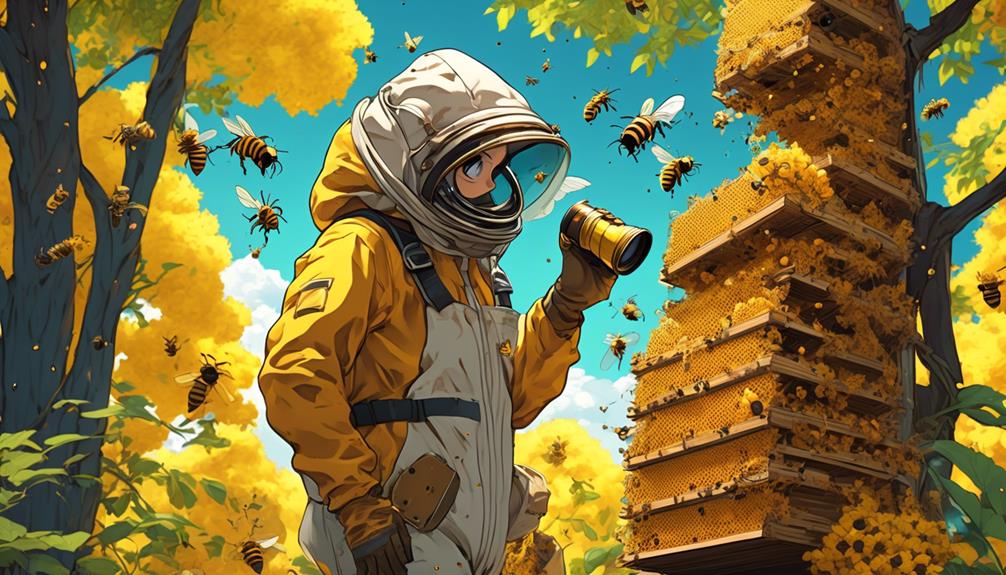
With the understanding of bee behavior under your belt, you're now better equipped to safely inspect the beehive in the tree. However, safety should always be your top priority. Don't attempt an inspection without the right protective gear. A beekeeper's suit, gloves, and a veiled hat are essential to protect you from potential stings.
Start your inspection from a safe distance and gradually move closer. If you notice aggressive behavior from the bees, such as increased buzzing or bees flying directly at you, it's best to retreat and try again later. Remember, the goal isn't to remove the bees immediately, but to understand the hive's structure and activity.
When closer, look for the hive entrance, usually a small hole in the tree. Assess the size and shape of the hive without physically touching it. Use binoculars if necessary. Note the number of bees entering and exiting. This will give you an idea of the colony's size, which can help plan your removal strategy.
Protective Gear Recommendations
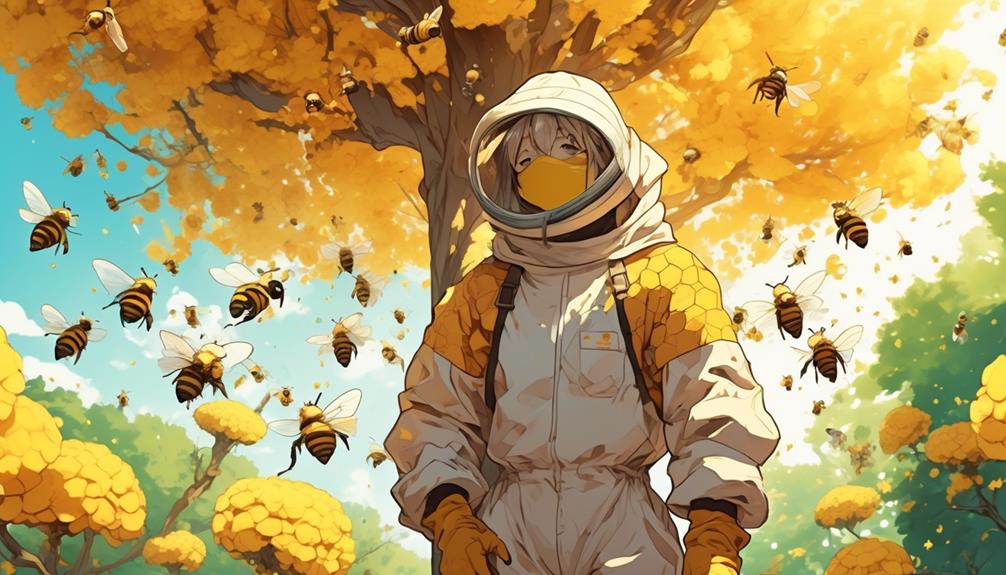
Before embarking on your bee removal mission, it's crucial to equip yourself with the right protective gear to prevent unwanted stings and ensure your safety.
Opt for a professional-grade bee suit made of thick, sting-proof material. This suit should cover your entire body, including hands, feet, and head. It should have a veil to protect your face without obstructing your vision.
Gloves are another important part of your protective gear. They should be made of leather or another thick material, extending up to your elbows to provide complete hand and arm protection.
Your boots should also be sturdy, preferably knee-high, and worn over the suit to prevent bees from crawling inside.
Remember, even the smallest exposed skin area can be a target for a defensive bee. Therefore, ensure no skin is exposed.
Lastly, consider using a smoker. This tool emits smoke that calms bees, making your job safer.
Investing in top-quality protective gear might seem costly, but remember, your safety is priceless. By taking these precautions, you're reducing your risk of bee stings, ensuring a safer bee removal process.
Natural Bee Repellents
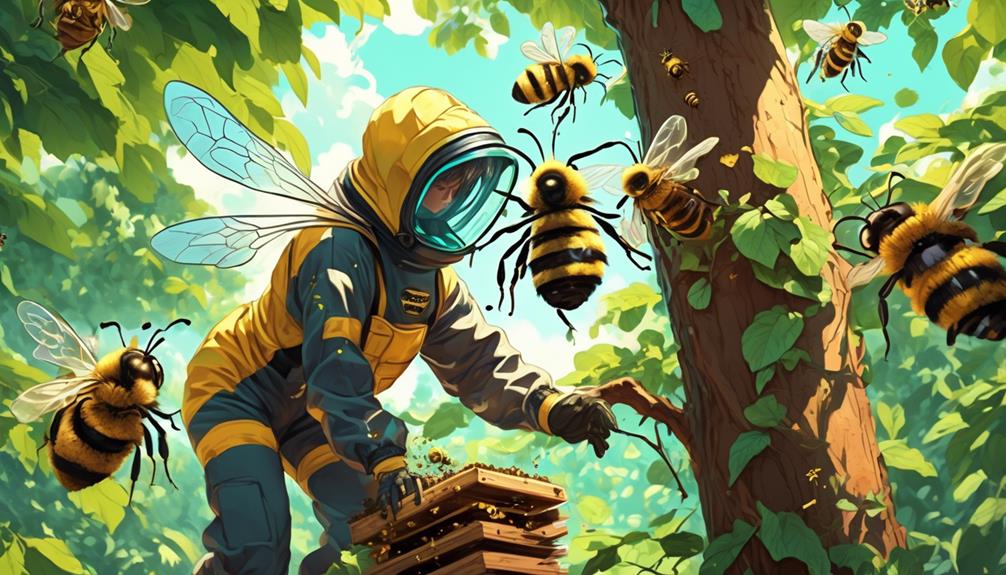
Having secured your safety with appropriate gear, let's now shift our focus to utilizing natural bee repellents as a non-lethal method of persuading the bees to vacate the tree.
Essential oils are a powerful tool in this endeavor. Peppermint, citronella, and tea tree oils, in particular, have proven to be quite effective. You'll want to dilute these oils with water – a ratio of 1 part oil to 2 parts water should suffice – and then spray the solution around the tree.
Another option at your disposal is vinegar. Simply mix equal parts water and vinegar in a spray bottle and apply it to the area. Bees despise the smell of vinegar, so this can be a very effective deterrent.
In addition, smoke is a traditional method used by beekeepers to calm bees and encourage them to vacate their hive. You can light a controlled fire with dry leaves or wood under the tree, ensuring the smoke reaches the bees without harming them.
Lastly, always remember that bees are crucial for the environment. When possible, call a professional beekeeper to safely remove and relocate them.
Contacting Professional Beekeepers
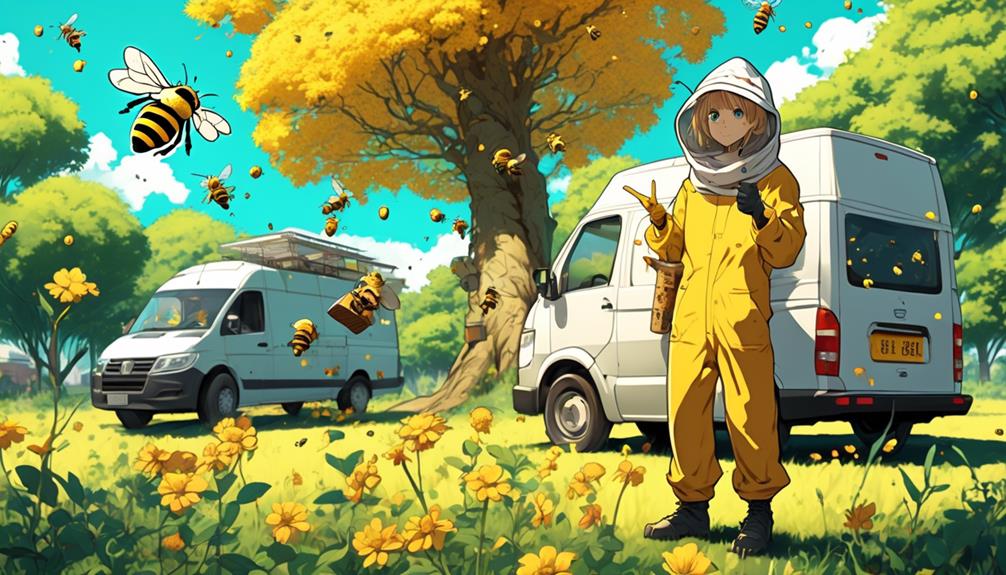
Navigating the process of contacting professional beekeepers can often feel daunting, but it's a vital step to ensuring the safe removal and relocation of the bees. Start by researching local beekeeping associations or clubs. They'll often have a list of trained, experienced beekeepers who can help.
When contacting a professional beekeeper, be prepared to provide detailed information about the bees and their location. Are they in a high or low branch? How large is the swarm? This information helps the beekeeper determine the best course of action.
Don't forget to discuss the cost. While some beekeepers may remove the bees for free, especially if they're a rare species, others may charge a fee. This fee covers their time, the risk involved, and the equipment they'll use.
Lastly, remember to ask about their process for removing and relocating the bees. You'll want to ensure they use safe, ethical methods that prioritize the bees' welfare. After all, bees play a crucial role in our ecosystem.
Aftercare and Prevention Measures

Once the bees are safely relocated by the professional beekeeper, it's important to turn your attention to aftercare and measures that can prevent a similar situation in the future.
The first step is to ensure that the tree is thoroughly inspected for any leftover honeycombs. If left behind, these could attract other bees or pests. You should hire a professional to remove them safely, or if you're handy, you could do it yourself, but caution is required.
Next, consider plugging up the hole or cavity where the bees had set up their hive. Use a safe, non-toxic material that won't harm the tree, such as a natural cork. This could deter bees from returning.
As a preventative measure, you might want to plant bee-friendly flora further away from your home. This can provide a more appealing environment for a new hive, reducing the likelihood of bees choosing your tree as their home.
Regularly inspect your trees for early signs of a hive as well, such as bees swarming or constant bee activity.
Frequently Asked Questions
What Should I Do if I'm Allergic to Bees and I Have a Bee Infestation in My Tree?
If you're allergic to bees, it's crucial to avoid direct contact. Don't try to handle the situation yourself. Instead, call a professional pest control service. They're trained to safely remove bees without causing harm.
Meanwhile, stay indoors as much as possible to avoid a potential allergic reaction. Remember, your health is paramount, so never risk it trying to solve a bee infestation on your own.
Can I Use Household Items to Make a Homemade Bee Trap?
Sure, you can create a homemade bee trap using household items. You'll need a plastic bottle, sugar, water, and some fruit. Cut the bottle in half, invert the top half into the bottom, add the bait, and place it near the bees.
They're attracted to the sweet scent but can't escape once inside. Remember, this method only attracts and traps bees, it doesn't solve a larger infestation problem.
Always consider professional help for serious infestations.
How Can I Tell if the Bees in My Tree Are an Endangered Species?
Identifying if the bees in your tree are endangered requires some knowledge and research. Begin by observing their physical characteristics and behaviors. Take clear photos if you can.
Then, consult a local beekeeping society, a university entomology department, or use online resources to compare your observations.
If you're still unsure, you might want to hire a professional. It's important not to disturb the bees, particularly if they're endangered.
What Is the Best Time of Day to Try to Remove Bees From a Tree?
The best time to attempt to remove bees from a location is during the late evening or early morning hours. At these times, bees are generally less active and more likely to be in their hive.
However, it's crucial to note that bee removal should be left to professionals to avoid harm to you or the bees. They're vital for our ecosystem, so proper, safe removal is key.
Are There Specific Types of Trees That Attract Bees More Than Others?
Sure, certain trees do attract bees more than others. Bees are especially drawn to trees with plentiful nectar and pollen, like willows, maples, and fruit trees. They're also attracted to trees that have cavities for nesting, such as old, hollowed-out trees.
Conclusion
In conclusion, dealing with bees in a tree is a delicate task. Understanding bee behavior, using safe inspection methods, and wearing protective gear are key.
Natural repellents can be effective, but if the situation's too tough, don't hesitate to call in a professional.
Remember, aftercare and prevention measures will help avoid a repeat scenario. Always prioritize safety and respect for these vital pollinators.
It's not just about removing bees, it's about co-existing with them.

